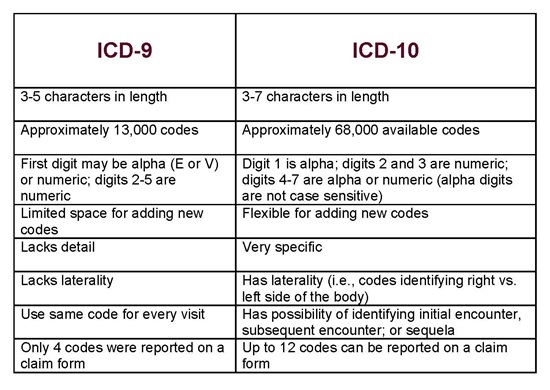 Anatomy of ICD-10 Codes Anatomy of ICD-10 Codes

The leap from ICD-9 to ICD-10 is significant, but you can more easily transition to the new ICD-10 codes if you understand their structure.
We encourage you to review all of the information provided via the following links, particularly the information found in the link to "The Tricky 7th Character".
Comparison of the Diagnosis Code Sets

ICD-10 Codes: Important Differences from ICD-9

1. Codes are alphanumeric and may be up to 7 characters in length.
2. 1st character is always alpha; alpha characters may appear elsewhere in the code as well. (Alpha characters are NOT case sensitive.)
3. 2nd character is always numeric.
4. The remaining 5 digits may be any combination of alpha/numeric.
5. All codes require a decimal after the third (3rd) character.
6. Laterality (side of the body affected) is required for certain codes. If a code requires laterality, it must be included in order for the code to be valid.
As a general rule:
The number 1 is used to indicate right side.
The number 2 is used to indicate left side.
The number 3 indicates bilateral.
The number 9 indicates side is unspecified in the medical record.
(For extremity-related and certain other diagnoses, "0" may be required, rather than "9".)
7. Addition of 7th character - required for certain codes, including 'S' codes (injuries and external causes), to provide information about the characteristic of the encounter. When required, one of the following alpha digits must be used in the 7th position for the code to be considered valid.
A = Initial encounter
D= Subsequent encounter
S = Sequelae (complications that arise as a direct result of a condition)
Please scroll down and review additional important information regarding initial and subsequent encounters and this 7th character, under "The Tricky 7th Character".
8. Addition of dummy placeholder "X" (to allow for future expansion):
"X" is required as a placeholder for the 5th character in certain 6 character codes.
"X' is required as a placeholder for the 5th and 6th character in certain 7 character codes.
When a placeholder character applies, it must be used in order for the code to be considered valid.
ICD-10 Code Structure
Characters 1-3 = Indicate the category of the diagnosis
Characters 4-6 = Indicate etiology, anatomic site, severity, or other clinical detail
Characters 7 = Extension
EXAMPLE - The following example shows the more detailed information gained through the added characters.
S52 Fracture of forearm
S52.5 Fracture of lower end of radius
S52.52 Torus fracture of lower end of radius
S52.521 Torus fracture of lower end of right radius
S52.521A Torus fracture of lower end of right radius, initial encounter, closed fracture
In the above example, S52 is the category. The fourth and fifth characters of "5" and "2" provide additional clinical detail and anatomic site. The sixth character (1) indicates laterality, i.e., right radius. The seventh character, "A", is an extension which, in this example, means "initial encounter".
The 5th and 6th character sub-classification represent the most accurate level of specificity.
All ICD-10 codes will begin with one of the following letters of the alphabet; the alpha characters are not case sensitive. The most commonly reported diagnoses for chiropractic are likely to begin with an "M" or an "S".
| A & B |
Infectious and Parasitic Diseases |
| C |
Neoplasms |
| D |
Neoplasms, Blood, Blood-forming Organs |
| E |
Endocrine, Nutritional, Metabolic |
| F |
Mental and Behavioral Disorders |
| G |
Nervous System |
| H |
Eye and Adnexa, Ear and Mastoid Process |
| I |
Circulatory System |
| J |
Respiratory System |
| K |
Digestive System |
| L |
Skin and Subcutaneous Tissue |
| M |
Musculoskeletal and Connective Tissue |
| N |
Genitourinary System |
| O |
Pregnancy, Childbirth and the Puerperium |
| P |
Certain Conditions Originating in the Perinatal Period |
| Q |
Congenital Malformations, Deformations and Chromosomal Abnormalities |
| R |
Symptoms, Signs and Abnormal Clinical and Lab Findings |
| S |
Injury, Poisoning, Certain Other Consequences of External Causes |
| T |
Injury, Poisoning, Certain Other Consequences of External Causes |
| U |
no codes listed, will be used for emergency code additions |
| V, W, X, Y |
External Causes of Morbidity (homecare will only have to code how patient was hurt; other settings will also code where injury occurred, what activity patient was doing) |
| Z |
Factors Influencing Health Status and Contact with Health Services (similar to current "V-codes") |
The Tricky "7th" Character (Initial vs. Subsequent Encounter)
One significant difference between ICD-9 and ICD-10 is the need to assign a 7th character, also called a 7th character extension, to codes in certain ICD-10-CM categories.
These 7th character extensions are found predominantly in two chapters of the ICD-10-CM/PCS (International Classification of Diseases, 10th Edition, Clinical Modification/Procedure Coding System), Chapter 19 - Injury, Poisoning and Certain Other Consequences of External Causes, which includes the "S" codes, and also in Chapter 15 - Pregnancy, Childbirth and the Puerperium.
This information only addresses the use of the 7th character for Chapter 19.
A seventh character must be assigned to codes in the "S" category (injury, poisoning, and certain other consequences of external causes) to provide information about the episode of care.
A = Initial encounter
D = Subsequent encounter
S = Sequela (complications that arise as a direct result of a condition)
CMS has provided the following information regarding episodes of care:
"A" (Initial encounter) - Initial encounter is defined as the period when the patient is receiving active treatment for the injury, poisoning, or other consequences of an external cause. An "A" may be assigned on more than one claim.
"D" (Subsequent encounter) - An encounter after the active phase of treatment and when the patient is receiving routine care for the injury during the period of healing or recovery.
"S" (Sequela) - Complications that arise as a direct result of a condition.
Important note - initial vs. subsequent encounter:
At this time it appears that chiropractors should use the 'A' with injury codes for as long as they deem the patient to be receiving "active treatment" (that is, as long as the patient continues to progress). When the patient ceases to progress (when MMI has been reached) but the physician continues treatment to facilitate healing, then the 'D' should be applied. As a general rule, when the code requires a 'D', it would indicate a non-covered service.
|




